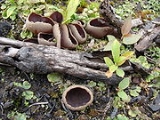
Peziza praetervisa
Encyclopedia
Peziza praetervisa, commonly known as the purple fairy cup or the fireplace cup, is a species of fungus in the genus Peziza
, family Pezizaceae. Recognized by its flattened, purple, cup-like fruiting bodies, this widespread fungus typically grows scattered or in clusters on burnt ground.
, is purple to purple-brown, but lightens to brown in age. The exterior surface is pale purple and scurfy (covered with small flakes or scales that are shed from the underlying surface). This species is sessile
, and does not have a stipe
. The flesh
is thin and mauve-colored.
, with small, fine warts on the surface, and have dimensions of 12–14 × 7 8 micrometre. They are biguttulate, containing two oil droplets at either end of the spore. The asci
are 250–300 × 10–12 µm. Like other Pezizales
, the asci open at maturity by means of an apical, lid-like flap of tissue termed an operculum
. The paraphyses
are club-shaped, filled with violet granules, and have bent tips; they are up to 7 µm wide.
, which may be distinguished from the latter by its dark purple hymenium, and microscopically by its biguttulate warty ascospores. Pachyella babingtonii also has a purple brown hymenium, but is smaller, and translucent in appearance.
Peziza
Peziza is a large genus of saprophytic cup fungi that grow on the ground, rotting wood, or dung. Most members of this genus are of unknown edibility and are difficult to identify as separate species without use of microscopy...
, family Pezizaceae. Recognized by its flattened, purple, cup-like fruiting bodies, this widespread fungus typically grows scattered or in clusters on burnt ground.
Description
Fruiting bodies resemble flattened cups with diameters of up to 3 centimetres (1.2 in). The inner spore-bearing surface, the hymeniumHymenium
The hymenium is the tissue layer on the hymenophore of a fungal fruiting body where the cells develop into basidia or asci, which produce spores. In some species all of the cells of the hymenium develop into basidia or asci, while in others some cells develop into sterile cells called cystidia or...
, is purple to purple-brown, but lightens to brown in age. The exterior surface is pale purple and scurfy (covered with small flakes or scales that are shed from the underlying surface). This species is sessile
Sessility (botany)
In botany, sessility is a characteristic of plants whose flowers or leaves are borne directly from the stem or peduncle, and thus lack a petiole or pedicel...
, and does not have a stipe
Stipe (mycology)
thumb|150px|right|Diagram of a [[basidiomycete]] stipe with an [[annulus |annulus]] and [[volva |volva]]In mycology a stipe refers to the stem or stalk-like feature supporting the cap of a mushroom. Like all tissues of the mushroom other than the hymenium, the stipe is composed of sterile hyphal...
. The flesh
Trama (mycology)
In mycology trama is a term for the inner, fleshy portion of a mushroom's basidiocarp, or fruit body. It is distinct from the outer layer of tissue, known as the pileipellis or cuticle, and from the spore-bearing tissue layer known as the hymenium....
is thin and mauve-colored.
Microscopic characteristics
Spores are elliptical, hyalineHyaline
The term hyaline denotes a substance with a glass-like appearance.-Histopathology:In histopathological medical usage, a hyaline substance appears glassy and pink after being stained with haematoxylin and eosin — usually it is an acellular, proteinaceous material...
, with small, fine warts on the surface, and have dimensions of 12–14 × 7 8 micrometre. They are biguttulate, containing two oil droplets at either end of the spore. The asci
Ascus
An ascus is the sexual spore-bearing cell produced in ascomycete fungi. On average, asci normally contain eight ascospores, produced by a meiotic cell division followed, in most species, by a mitotic cell division. However, asci in some genera or species can number one , two, four, or multiples...
are 250–300 × 10–12 µm. Like other Pezizales
Pezizales
The Pezizales are an order of the subphylum Pezizomycotina within the phylum Ascomycota. The order contains 16 families, 199 genera, and 1683 species. It contains a number of species of economic importance, such as morels, the black and white truffles, and the desert truffles. The Pezizales are...
, the asci open at maturity by means of an apical, lid-like flap of tissue termed an operculum
Operculum (botany)
An operculum, in botany, is a term generally used to describe a structure within a plant, moss, or fungus acting as a cap, flap, or lid. In plants, it may also be called a bud cap.Examples of structures identified as opercula include:...
. The paraphyses
Paraphyses
Paraphyses are part of the fertile spore-bearing layer in certain fungi. More specifically, paraphyses are sterile filamentous hyphal end cells composing part of the hymenium of Ascomycota and Basidiomycota interspersed among either the asci or basidia respectively, and not sufficiently...
are club-shaped, filled with violet granules, and have bent tips; they are up to 7 µm wide.
Habitat and distribution
P. praetervisa is a widespread fungus that grows in scattered clusters on burned soil, and is often found on the remains of old campfires.Similar species
Other mushrooms resembling P. praetervisa include Peziza violaceaPeziza violacea
Peziza violacea, commonly known as the violet fairy cup or the violet cup fungus, is a species of fungus in the genus Peziza, Pezizaceae family. As both it common names and specific epithet suggest, the cup-shaped fruiting bodies are violet colored on the interior surface. P...
, which may be distinguished from the latter by its dark purple hymenium, and microscopically by its biguttulate warty ascospores. Pachyella babingtonii also has a purple brown hymenium, but is smaller, and translucent in appearance.
External links
- Fungi of Poland Several photos

